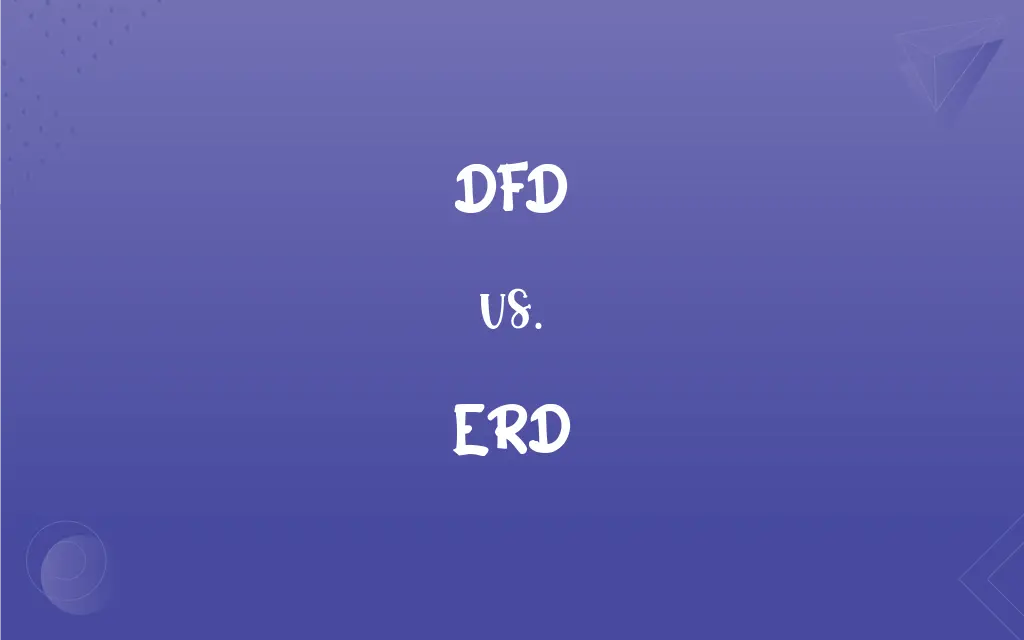DFD vs. ERD: What's the Difference?
Edited by Harlon Moss || By Janet White || Published on March 1, 2024
DFD (Data Flow Diagram) visualizes data flow in a system, while ERD (Entity-Relationship Diagram) represents relationships between data entities.

Key Differences
DFD illustrates how data moves through a system, highlighting processes that data undergoes. ERD, on the other hand, focuses on the data's structure within the system, showing how entities relate to each other.
DFD is process-oriented, concentrating on the flow of data between processes. ERD is structure-oriented, concentrating on the relationships and attributes of data entities.
In DFDs, the emphasis is on sequences and pathways of data, often abstracting the actual data contents. ERDs provide a detailed look at the data itself, its attributes, and how entities are interconnected.
DFDs are used to map out the logical flow of information in the system, beneficial in the initial phases of software development. ERDs are instrumental in database design, focusing on data requirements and how they interconnect.
In DFDs, circles or ovals represent processes, whereas in ERDs, entities are depicted as rectangles, and their relationships are indicated by connecting lines.
ADVERTISEMENT
Comparison Chart
Primary Focus
Data movement and processes
Data entities and relationships
Diagram Nature
Process-oriented
Structure-oriented
Use in System Development
Emphasizes sequence and pathways of data
Focuses on data structure and database design
Key Components
Processes, data stores, data flows
Entities, relationships, attributes
Representation Style
Depicts processes as circles or ovals
Shows entities as rectangles, relationships as lines
ADVERTISEMENT
DFD and ERD Definitions
DFD
DFD depicts how data is processed and transformed in a system.
Our team used a DFD to trace the error in the data processing module.
ERD
ERD is a diagram that shows the relationships between different data entities.
The ERD made it easier to comprehend the complex relationships in our database.
DFD
DFD illustrates the movement of data between processes and data stores.
The new DFD clearly showed the data flow from the login screen to the user database.
ERD
ERD helps in the conceptual design of databases by illustrating entity attributes.
The ERD displayed all attributes of the 'Employee' entity, including their relationships.
DFD
DFD provides a visual understanding of how data is handled within a process.
The project manager presented a DFD to explain the proposed changes in data handling.
ERD
ERD visually represents the structure of a database.
We created an ERD to facilitate the redesign of our customer database.
DFD
DFD is a graphical representation of data flow in a system.
The DFD helped us understand how customer data is processed in the application.
ERD
ERD is used to model the data requirements and schema of a system.
Our ERD was crucial in understanding how user data was organized.
DFD
DFD is a tool used in systems analysis to show data inputs, processes, and outputs.
By analyzing the DFD, we identified redundant data inputs in the system.
ERD
ERD outlines how entities in a system are related and interconnected.
The database team used an ERD to explain the new relationship between products and orders.
ERD
Tlb|en|dialect|rare}} {{alternative form of earth
ERD
(zoology) The common European shrew (Sorex vulgaris); the shrewmouse or erd shrew.
ERD
The earth.
FAQs
What is the main purpose of a DFD?
To illustrate how data flows and is processed in a system.
Can DFDs be used for database design?
While helpful in understanding processes, DFDs are less focused on database structure, unlike ERDs.
What does DFD stand for?
Data Flow Diagram, a tool used in systems analysis.
Are DFDs complex?
They can range from simple to complex, depending on the system's size and complexity.
How does a DFD help in software development?
It aids in visualizing data processing steps, essential for system planning and troubleshooting.
Are ERDs important in database management?
Absolutely, they are fundamental in designing and understanding database relationships.
Can ERDs be used in system analysis?
Yes, particularly for understanding and designing database structures.
What is ERD?
Entity-Relationship Diagram, a tool for modeling data relationships in a system.
How does ERD differ from DFD?
ERD focuses on data structure and relationships, while DFD focuses on data flow and processes.
Do DFDs show data storage?
Yes, they represent data storage points, but not in as much detail as ERDs.
Can ERDs show many-to-many relationships?
Yes, ERDs can effectively illustrate complex relationships, including many-to-many.
What are entities in an ERD?
Entities represent data objects or concepts, like 'Customer' or 'Order'.
How are relationships represented in an ERD?
Through lines connecting entities, often labeled to describe the nature of the relationship.
Is ERD more focused on logic or physical structure?
ERD is more logically oriented, focusing on how entities are conceptually related.
What's a process in a DFD?
It's an operation or task that data undergoes, represented by a circle or oval.
How does an ERD assist in normalization?
It helps in organizing data elements and their relationships, crucial for database normalization.
Is a DFD useful for end-users?
It can be, especially for understanding the general flow of data in a system.
Can DFD and ERD be used together?
Yes, they complement each other in system analysis and design.
What's the first step in creating a DFD?
Identifying and understanding the major processes involved in the system.
Do DFDs include decision points?
Not typically; they focus more on the flow rather than decision-making.
About Author
Written by
Janet WhiteJanet White has been an esteemed writer and blogger for Difference Wiki. Holding a Master's degree in Science and Medical Journalism from the prestigious Boston University, she has consistently demonstrated her expertise and passion for her field. When she's not immersed in her work, Janet relishes her time exercising, delving into a good book, and cherishing moments with friends and family.
Edited by
Harlon MossHarlon is a seasoned quality moderator and accomplished content writer for Difference Wiki. An alumnus of the prestigious University of California, he earned his degree in Computer Science. Leveraging his academic background, Harlon brings a meticulous and informed perspective to his work, ensuring content accuracy and excellence.































































